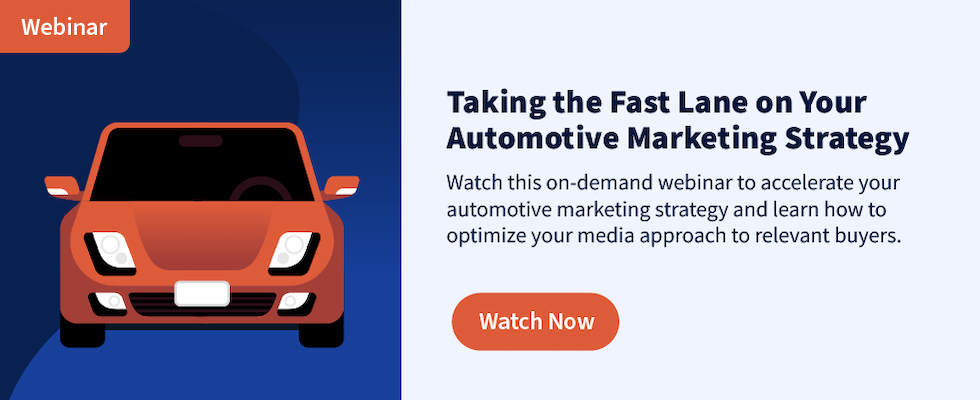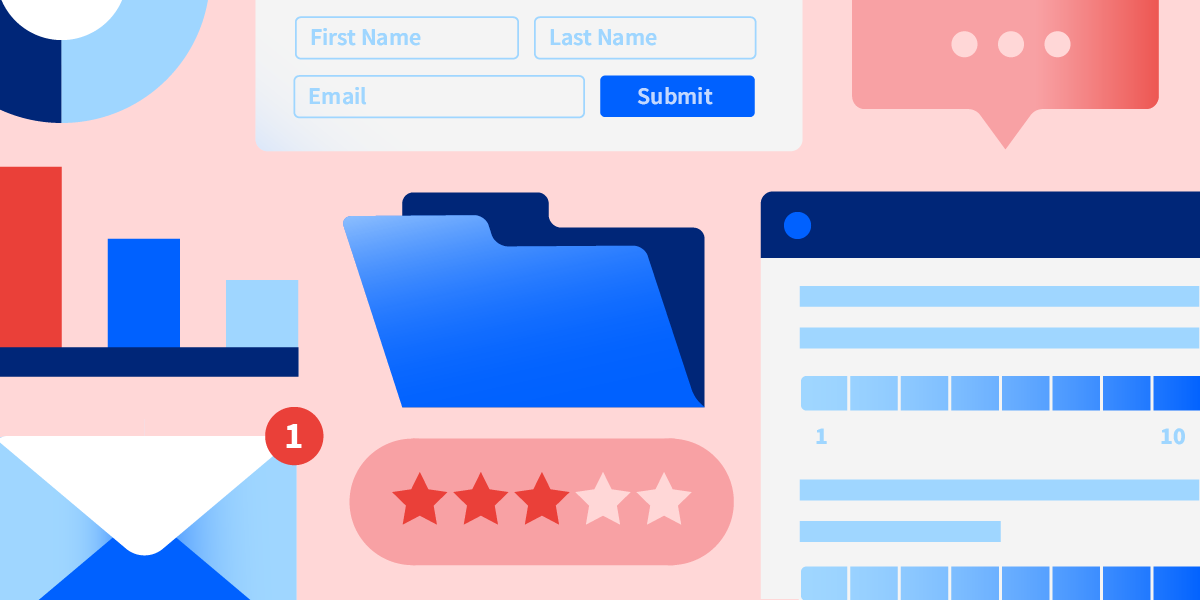Automotive advertising is a challenging industry! The sales cycle for large purchases like new vehicles are often long and require multiple touch points throughout the funnel. But, don’t let a few bumps in the road discourage you.
The auto industry accounted for 23% of all retail sales in the US in 2022. This represents a significant portion of overall consumer spending, and it’s expected that spend in the auto industry will continue to grow.
The Lowdown on Automotive Industry Advertising
Before we dive into automotive advertising strategies, it’s important to highlight why this retail industry is unique. A key differentiator is that vehicles are a massive financial investment. As a result, consumers spend a long time in the consideration phase.
Car buyers spend an average of nearly 14 hours online during their research, and visit an average of 4.2 websites in their purchasing process. The buying journey almost always starts online, which means reaching consumers with a programmatic campaign will come long before they step foot in a car dealership.
Read on for 6 automotive advertising strategies, and automotive marketing trends that will help you tap into this massive retail category and drive performance for your campaigns.
6 Automotive Advertising Strategies
1. Leverage weather targeting to reach consumers at the right moment.
The auto industry is influenced heavily by weather conditions, particularly in the US, where weather can vary drastically throughout the year.
When temperatures start to drop, consumers are thinking about purchasing winter tires to keep safe on the road. For example, after an intense storm, consumers will consider buying a vehicle that has added safety features, like all-wheel drive. On the flip side, when hot temperatures arrive across the US, consumers start thinking about features like air conditioning.
For automotive advertising, weather targeting helps car dealerships and manufacturers to reach audiences in receptive moments. You’re able to set parameters for running a winter tires campaign right when temperatures drop, or when the first snowstorm hits. Or, set campaigns highlighting climate control for when temperatures begin to rise. This way, you reach consumers when specific car features are top of mind.
2. Use video to capture attention and convey information.
Cars and other auto related items in the automotive vertical are generally big ticket purchases. Therefore, consumers will want details about a product before converting. With video advertising, you’re able to communicate a lot of information by combining visual and audio elements. With just a few seconds or a minute, you can tell your ideal audience everything they should know about your brand or your product.
Watching videos is becoming a daily habit for US adults. More than 75% of adults spend up to 2 hours watching short-form digital video content every day. In 2022, more than 82% of all consumer internet traffic watched online videos, which is 15 times higher than in 2017.
Time spent with video continues to grow, and so investment in this programmatic channel is growing, too. According to eMarketer, US advertisers increased their spend from $52.17 billion USD in 2021 to $62.96 billion USD in 2022.
Video enables automotive advertisers to convey key info in a short period of time. You can do more than just introduce a vehicle or a service. You can educate your audience, and start building trust between them and your brand.
3. Connect with local consumers through geotargeting.
In the digital age, many consumers start their research process for new vehicles and other products in the auto vertical online. But, walking into a nearby car dealership remains the common form of initial contact, by more than half of car shoppers.
This is why geotargeting is such an important automotive industry advertising strategy. Your audience will likely come into a brick and mortar location at some point. In most cases, they will visit a dealership that is within the vicinity of their home. Auto dealerships can use a geotargeting strategy, which leverages a combination of location-based tactics to reach a desired audience of consumers who live in their vicinity.
The best way to do this is with a geofence, which is a virtual fence that encloses a perimeter around a geographic location. This enables you to reach consumers within a specific neighbourhood, building, or another real-world location.
4. Reach an engaged, broad audience through in-game ads.
In-game ads appear on objects such as billboards, walls, jerseys, and more during video gameplay. The goal of in-game advertising is to insert ads that are noticed by a player, but don’t interrupt their enjoyment of the game.
You can leverage in-game advertising to capture the attention of audiences in the top of the funnel in a non-disruptive, highly-viewable environment.
This is a valuable channel for automotive advertising because the in-game audience encompasses various demographics. Players are highly engaged and usually aren’t multi-tasking, which means more attention is spent on your ad, increasing the likelihood of brand recall and awareness.
5. Align with consumers using contextual advertising.
Consumer ad preferences and privacy-driven changes in the digital advertising landscape are evolving. As a result, marketers are increasingly turning to contextual advertising. Contextual advertising targets ads based on the environment that the ad appears in. This targeting strategy helps you reach users while they are in a relevant frame of mind, which is indicated by the content they are consuming.
This is a crucial automotive advertising strategy because the sales cycle for this vertical is so long. Because contextual advertising taps into the current frame of mind of a consumer, it’s perfect for building brand awareness and keeping users engaged throughout the funnel.
With contextual ads, you can target niche phrases that are related to your auto product or service. For example, if you’re promoting winter tires, targeting keywords like “driving in snow” will ensure your ad appears alongside, let’s say, a blog that includes tips for driving in winter weather. Your ad, therefore, will reach your target audience with precision, at a moment when winter tires are top of mind.
6. Re-engage users in the funnel with retargeting.
Throughout a long sales cycle, retargeting is key. Automotive retargeting advertising allows you to re-engage a user that has shown interest in your vehicles, auto products, or services. This strategy delivers online ads to a user based on their previous intent-based actions on the web.
To create an effective retargeting strategy, you’ll first need to identify where in the funnel a consumer should be when they are served a follow-up ad. This strategy is beneficial all throughout the customer journey, including at the top of the funnel, when a user has just been introduced to your brand, or for when a user is in the consideration stage, and is continuing to explore your product or service.
Including automotive retargeting advertising in your auto advertising strategy will help to drive continued engagement and conversions. It’ll ensure that regardless of what device or channel your ideal audience is using, they’ll see your ad!
Leverage Multi-Channel in Your Automotive Marketing Strategy
The greatest challenge for marketers in the auto industry is driving users through the often lengthy path to purchase. Since people today are online on a variety of devices, and using a variety of channels, it’s crucial to have coverage across multiple digital environments.
Multi-channel targeting enables advertisers to reach users across different platforms and channels. This helps a campaign achieve greater reach by capturing users wherever they are online.
The key to a successful multi-channel auto campaign is to create a cohesive message across all of the available channels. This will lift brand awareness and inch those users closer to conversion. Just be sure to leverage the right media mix to reach your ideal audience where they are, create visibility for your brand, and engage consumers.
Get Started With Automotive Marketing
There’s a lot to consider when you’re building out an automotive advertising strategy. You’ll need to land on the right mix of channels, targeting tactics, ad formats, copy, and so much more.
Finding the right formula isn’t one size fits all. It takes plenty of experimentation to steer your campaigns toward the media mix that will take your audience from the consideration stage, to conversion. Your best bet? Don’t shy away from new channels or strategies, because that channel you haven’t run before might help you fuel your auto advertising success.
Ready to drive auto advertising performance? Request a demo to learn more about StackAdapt.






